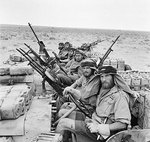Fairbairn-Sykes Blade
| Country of Origin | United Kingdom |
| Type | Blade |
| Length | 290.000 mm |
Contributor: C. Peter Chen
ww2dbaseThe Fairbairn-Sykes commando daggers originated from a design by British Shanghai Municiple Police officers William Fairbairn and Eric Sykes in the 1930s. In 1940, both of them retired from the Shanghai Municiple Police. Amidst the European War, Winston Churchill advocated for the formation of a small commando force to "set Europe ablaze" while the British military recuperated from the devastating losses in early months of the war; in Nov 1940, Fairbairn and Sykes were consulted by the director of the company Wilkinson Sword Limited John Wilkinson-Latham to develop a fighting knife for the commando units that were beginning to form. Fairbairn and Sykes, following the same design philosophy as they had in China, developed a dagger that was double-edged for both slashing and stabbing and heavy at the hilt for better balance. The first prototype was made by Wilkinson's head of experimental workshop Charles Ross, which was accepted by the British War Office, resulting an order of 6,000 to 7,500 examples at the cost of 13 shillings 6 pence each (about US$4.25); various military units such as the Special Operations Executive also placed orders, totaling about 1,000 examples. The first of the first pattern daggers were delivered in Jan 1941, and the second pattern daggers with simplified design for faster production began to be seen in Aug of the same year, superseding production of the first pattern. In Oct 1942, an order for 38,700 second pattern daggers was placed. On 6 Feb 1943, Wilkinson would receive two orders, 10,000 all-black daggers at 17 shillings 6 pence each and 154,000 daggers at 17 shillings and 4 pence each; these would prove to be the final orders of the war. In late 1943, the design was simplified further; these mass-produced daggers were generally called third pattern Fairbairn-Sykes daggers. Allied commandos trained in the use of Fairbairn-Sykes daggers were taught to cut the enemies' arteries in the arms, deep under the shoulders, necks, and stomachs to dispatch opposition quickly, though messily.Wilkinson Sword's records show that 6,779 first pattern, 40,923 second pattern, and 163,565 third pattern were made for the British government; these figures did not include private sales (the company, for example, sold these daggers to private parties from its Pall Mall shop). Other companies such as Sheffield Cutlery also produced these daggers during the war in large quantities.
The Fairbairn-Sykes commando daggers design was known to have influenced many fighting knives produced around the world, such as the United States Marine Corps' Raider stiletto.
Source: Leroy Thompson, Fairbairn-Sykes Commando Dagger ww2dbase
Last Major Revision: Apr 2011
Photographs
 |  |
Fairbairn-Sykes Timeline
| 6 Feb 1943 | Wilkinson Sword Limited received renewed contracts to produce more Fairbairn-Sykes commando daggers; they would be the firm's final government contracts of the war. |
| 10 Apr 1945 | Wilkinson Sword Limited's contract for producing Fairbairn-Sykes commando daggers ended. |
Please consider supporting us on Patreon. Even $1 per month will go a long way! Thank you. Please help us spread the word: Stay updated with WW2DB: |
Change View
Desktop ViewSearch WW2DB
More on Fairbairn-Sykes
Related Book:» Fairbairn-Sykes Commando Dagger
Current Site Statistics
- » 1,151 biographies
- » 337 events
- » 44,186 timeline entries
- » 1,243 ships
- » 350 aircraft models
- » 207 vehicle models
- » 375 weapon models
- » 123 historical documents
- » 260 facilities
- » 470 book reviews
- » 28,668 photos
- » 431 maps
Famous WW2 Quote
"With Germany arming at breakneck speed, England lost in a pacifist dream, France corrupt and torn by dissension, America remote and indifferent... do you not tremble for your children?"Winston Churchill, 1935